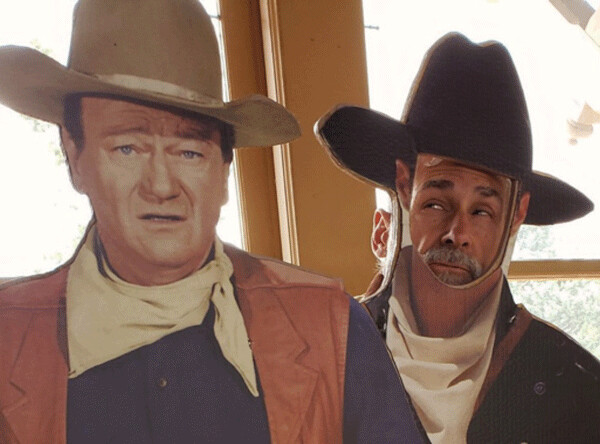News & Articles
Browse all content by date.

When I was a Cold War kid I paged through a lot of Arizona Highways. It was a popular magazine in dentist offices. The eye-popping colors were dismissed by drab Soviet critics as unrealistic American propaganda. That was high praise indeed but entirely false. My cell phone is crammed full of similar pictures.
I’m returning to snowy Duluth after a twelve-night romp through the state. The last time I paid a call was for a celebration of my Aunt Mary’s life after her death. This visit’s happier occasion began with the marriage of her granddaughter to a childhood sweetheart, a young Jewish fellow. I don’t know if the bride knew that seventy years earlier her great-grandmother talked her grandmother out of a similar union by asking my Aunt if she really wanted to raise her children in the Jewish faith. No one threw cold water on this wedding which concluded with the good luck stomping of a glass goblet and a joyous chorus of Hava Nagila during which the couple, seated on chairs, were raised high over the dance floor as though in a mosh pit.
I learned my state capitals in fifth grade. Back then Arizona was a baby state, the last admitted to the Union. (Alaska and Hawaii would soon take its place in the nursery). All the other states seemed to get their centennial postage stamps in the 1950’s. I remember my Dad growing a beard for the Kansas Centennial. Laggard Arizona only got a 50-year birthday stamp in 1962.
The year of its admission, 1912, was a big election year. Ex Prez, Teddy Roosevelt, challenged the Republican party’s nominee as a “progressive” third-party candidate. That was year my Grandfather, George Robb, graduated from tiny Park College where he was likely a member of the Roosevelt Club. In 1914 he got a teaching job at Mesa, Arizona’s high school. He was called “professor” and while there he noted the entrepreneurial success of Arizona’s first big Retail store family, the Goldwaters. Years later, in 1964, he would regard the Goldwater’s son, Barry, as his beau ideal for President. That was the year my Mother broke her father’s heart and voted for Lynden Johnson. Although retailer Goldwater was a Russian Jew he deferred to his wife who raised their son who would become a nominal Episcopalian – something my Aunt’s mother never suggested as a possibility.
Long after my Mom disappointed her father, I came to admire Goldwater too. He told Dick Nixon to resign to keep the country whole and the Republican Party honest. Later, decades before Pete Buttigieg’s presidential run, Goldwater cantankerously decried Christian bigotry against Gays.
After the wedding we spent a couple nights in Sedona. This dot on the map surrounded by picturesque rocks became one of Hollywood’s favorite places to make western myths thanks to John Wayne who wanted to direct his first movie there. Hollywood made him build a motel first so there would be no daily commute from distant Flagstaff. The result was a very charming The Bad Man and the Angel. Many more westerns would follow.
We watched that black and white film and later a post WW II Western in our Sedona hotel. The later second movie, Broken Arrow, was an attempt at some post war rapprochement with Native Americans. Hollywood had previously treated them as foils and savages. By today’s standards Broken Arrow is a little painful to watch. Jimmy Stewart’s young Apache wife has to be murdered by bad white men Shade’s of my grandmother’s nightmare perhaps? But the movie was a step away from Hollywood’s and America’s very real Indian holocaust.
As much as today’s Republicans like to badmouth Hollywood’s influence a lot of it was uplifting. In the westerns the guns were often taken off for church services. Ask the NRA about that! One of my favorites was The Man Who Shot Liberty Valance another later classic with Jimmy Stewart. While the state being depicted wasn’t spelled out it was surely Arizona. A young eastern educated lawyer comes to bring the law to the West. He’s met by Liberty Valance a deliciously detestable Lee Marvin. There is a love interest and Stewart, the clueless idealist, fights for her with an ornery old realist rancher played by John Wayne.
Corrupt interests run the town and they count on Liberty to chase out the young lawyer who wants to mess everything up with government, law and decency. As the title suggests there is a mystery and the victim is obvious from the moment you read the theater Marquee. That mystery is answered by the man who gets the girl and the credit for the killing. I used to sing the title song to my Mother when visiting her in the memory ward of Bayshore Nursing. It seemed right. The man who shot Liberty became the state’s Territorial Governor not unlike my Grandfather, the one-time Arizona professor who was appointed a state official for winning a Congressional Medal of Honor in World War I.
Harry waxes poetic about other westerns at lincolndemocrat.com or check back issues of the Reader under “The Wayning of America” or “Whatever Happened to the Magnificent Seven.
| Tweet |


